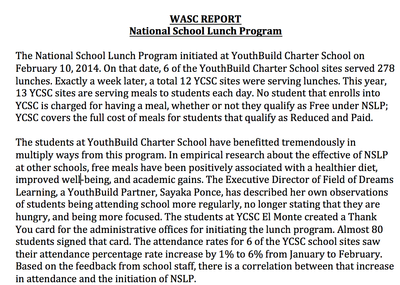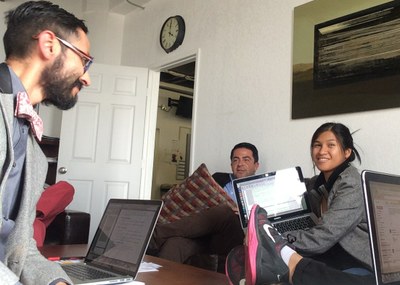School Accountability
WASC REPORT & REVISIT
This year, I joined the WASC Committee to prepare for YouthBuild Charter School's 3 year revisit. My primary responsibilities involved writing two portions of the report. First, another teacher, Sayaka Ponce, and I wrote about the implementation of the National School Lunch Program at our school. We began serving lunches the previous school year. The teacher and I documented the human and fiscal resources involved. After looking at some research, we wrote about the health and cognitive benefits of meals for low-income youth. Finally, we collected some data to show a slight increase in attendance rates after the adoption of NSLP.


A Site Coordinator, Sonia Hernandez, and I volunteered to write the Schoolwide Action Plan. This involved reviewing the previous action plans in order to document changes to our current practices. We also had to work with all of the other subcommittees to document their work and represent their reports in the action plan. Finally, we had to share multiple drafts of our plan with other committee members and our stakeholders in order to gather feedback. The changed the format of the SWAP to include outcomes and a timeline and assure readability. We also dramatically increased the amount of information and detail of the document; the document is now 16 pages long.

The revisit progressed positively. The WASC Visiting team complimented our school in its authentic learning model, its partnership with community organizations, and its success in promoting student learning. The visiting team determined that we had met or exceeded all of the critical areas for follow up from the previous WASC review.
LOCAL CONTROL ACCOUNTABILITY PLAN
Working with a team in headquarters, I helped to write the LCAP annual update. I joined the team after its initial meetings. During those meetings, the team reviewed the first LCAP and identified data that need to be collected and updates to me made in the new document. After joining the team, I helped review the data and information that we collected around: stakeholder feedback, 3 goals (interdisciplinary education, subgroup data, post-secondary), and budget. Our 3 goals for the upcoming year are:
- Achieve student growth in core content proficiency by using an interdisciplinary model that can be measured by state assessments and a qualitative review of student work
- Close the achievement gap for the charter school's lowest performing subgroups
- All students who graduate are post-secondary ready with access to careers and post-secondary education


After I joined the LCAP team, UCLA Professor Gandara visited one of my classes to present a report that she wrote, titled "Seizing the Opportunity to Narrow the Achievement Gap for English Learners." This report provides a substantial number of suggestions on ways that schools can use LCAP funds to impacts marginalized students. Although this information came too late to make a significant impact on our discussions, I shared the report and noted some of suggestions that align to our school mission to create welcoming, supporting, and empowering environments for our students and the communities that we serve:
- Increase social workers, parent liaisons, nurses, counselors, psychologists, and librarians with specialization in books about the cultures and in the languages of the students, and who to the extent possible, are bilingual.
- Ensure adequate nutrition during school hours.
- Use bilingual parent liaisons to develop links between the community and school.
- Train personnel to evaluate transcripts from non-U.S. schools so that students can be accurately placed and receive credit for courses taken and passed outside the U.S.
- Link every EL student to at least one extra-curricular activity of his or her choice.
- Incorporate innovative measures to reduce racial, socio-economic, and linguistic segregation among students.
- Provide career and college planning guidance geared to EL’s needs.
LEADERSHIP
Through my involvement with the WASC Committee and the LCAP revision process, I demonstrated and developed many CAPEs.
- CAPE 1: Developing and Articulating a Vision of Teaching and Learning for the School
-
CAPE 8: Communicating With the School Community about School-wide Outcomes Data and Improvement Goals
- CAPE 9: Working with Others to Identify Student and School Needs and Developing a Data Based School Growth Plan
- CAPE 11: Identifying and Using Available Human, Fiscal, and Material Resources to Implement the School Growth Plan
- CAPE 17: Developing, Implementing, and Monitoring the School’s Budget
- CAPE 18: Implementing California School Laws, Guidelines, and Other Relevant Federal, State, and Local Requirements and Regulations
- CAPE 20: Involving the Community in Helping Achieve the School’s Vision and Goals
NEXT STEPS
Our YCSC leadership team has already had preliminary discussions about preparing for the next WASC visit. This will consist of a full self-study. Given our development of a new integrated curricular model, we will need to carefully measure the impact of this model of student learning, school culture, curriculum, instruction and in meeting our school vision.
During the upcoming year, we plan on closely tracking our progress in meeting our LCAP goals. We have already shared these goals with our closest stakeholders in the community. Two out of the three goals are related to two new school initiatives, the integrated curriculum model and post-secondary programs. Our school plans on ensuring that these initiatives are closely monitored and improved in order to promote student success.

